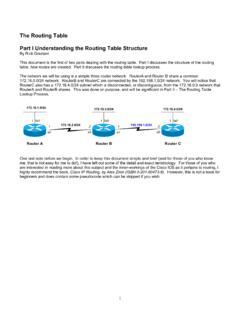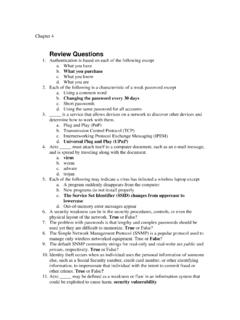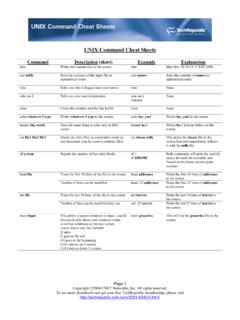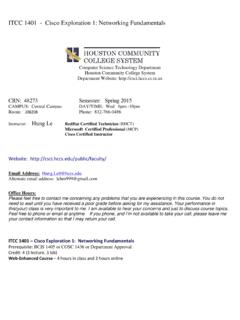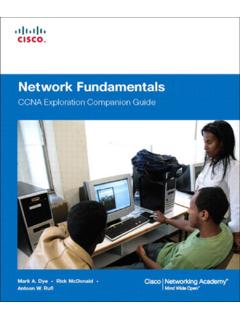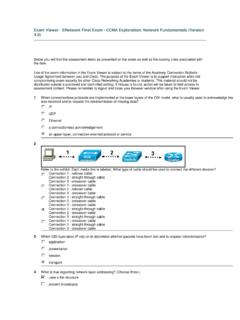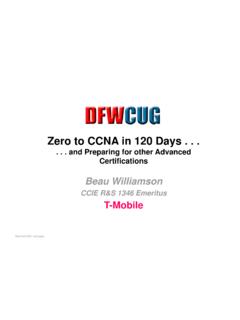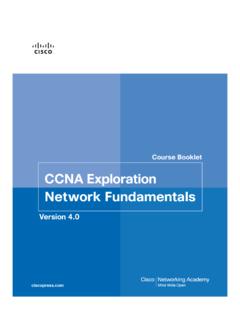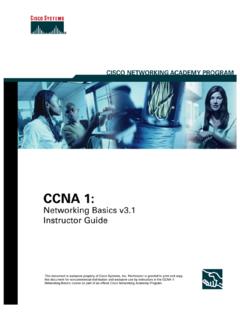Transcription of 6-22 Exploration Scope & Sequence - Del Mar College
1 Page 1 of 15 Scope and Sequence ccna Exploration The course objectives and outline of the final two ccna Exploration courses, LAN Switching and Wireless and Accessing the WAN, are subject to change since the courses are still under development. The English versions of those two courses are scheduled to be available in the November December 2007 timeframe. Target Audience The target audience for ccna Exploration includes Cisco Networking Academy students with advanced problem solving and analytical skills typically associated with degree programs in engineering, math, or science. Prerequisites ccna Exploration is composed of four courses: network fundamentals , Routing Protocols and Concepts, LAN Switching and Wireless, and Accessing the WAN. network fundamentals is the first course and it has no prerequisites. It is a prerequisite for the other three courses. Routing Protocols and Concepts is the preferred second course in the Sequence , but variations are possible as shown in Figure 1.
2 LAN Switching and Wireless can be taught before Routing Protocols and Concepts, or concurrently. LAN Switching and Wireless can also be taught at the same time as Accessing the WAN, after Routing Protocols and Concepts. Figure 1. ccna Exploration Course Delivery Options network fundamentals network fundamentals Routing Protocols and Concepts Accessing the WAN LAN Switching and Wireless Routing Protocols and Concepts Accessing the WAN LAN Switching and Wireless network fundamentals Routing Protocols and Concepts Accessing the WAN LAN Switching and Wireless network fundamentals Routing Protocols and Concepts LAN Switching and Wireless Accessing the WAN Page 2 of 15 Target Certifications After completing ccna Exploration , students will be prepared to take the ccna Certification Exam. Curriculum Description This curriculum presents a comprehensive overview of networking; from fundamentals to advanced applications and services. It is based on the top2down approach to networking that is popular in many colleges and universities.
3 The course emphasizes concepts and skills required to design networks, while providing opportunities for practical application and hands2on experience by teaching students how to install, operate, and maintain networks. Some of the main features of ccna Exploration are as follows: Can be part of an integrated curriculum or continuing education program at postsecondary institutions such as career and technical schools, colleges, and universities Allows students to learn skills in a more comprehensive, theoretical, and practical way that is reflective of common educational practices at the College level; and uses language that integrates related engineering concepts Presents comprehensive coverage of networking topics, ranging from fundamentals to advanced applications and services Includes highly2complex and challenging hands2on labs Offers more flexibility in the curriculum delivery and permits shortened course delivery time Helps prepare students for continuing education and professional careers in IT Curriculum Objectives This curriculum provides students with the skills needed to succeed in networking2related degree programs and helps them prepare for ccna certification.
4 It also helps students develop the skills necessary to fulfill the job responsibilities of network technicians, network administrators, and network engineers. It provides a theoretically2rich, hands2on introduction to networking and the Internet. Upon completion of the network fundamentals course, students will be able to perform the following tasks: Explain the importance of data networks and the Internet in supporting business communications and everyday activities Explain how communication works in data networks and the Internet Recognize the devices and services that are used to support communications across an Internetwork Use network protocol models to explain the layers of communications in data networks Explain the role of protocols in data networks Describe the importance of addressing and naming schemes at various layers of data networks Describe the protocols and services provided by the Application layer in the OSI and TCP/IP models and describe how this layer operates in various networks Analyze the operations and features of the Transport layer protocols and services Analyze the operations and feature of the network layer protocols and services and explain the fundamental concepts of routing Page 3 of 15 Design, calculate.
5 And apply subnet masks and addresses to fulfill given requirements Describe the operation of protocols at the OSI Data link layer and explain how they support communications Explain the role of Physical layer protocols and services in supporting communications across data networks Explain fundamental Ethernet concepts such as media, services, and operation Employ basic cabling and network designs to connect devices in accordance with stated objectives Build a simple Ethernet network using routers and switches Use Cisco CLI commands to perform basic router and switch configuration and verification Analyze the operations and features of common Application layer protocols such as HTTP, DNS, DHCP, SMTP, Telnet, and FTP. Utilize common network utilities to verify small network operations and analyze data traffic. Upon completion of the Routing Protocols and Concepts course, students will be able to perform the following functions: Describe the purpose, nature, and operations of a router Explain the critical role routers play in enabling communications across multiple networks Describe the purpose and nature of routing tables Describe how a router determines a path and switches packets Explain the route lookup process and determine the path packets will take in the network .
6 Configure and verify basic router operation for a newly installed router Describe the purpose and procedure for configuring static routes Configure and verify static and default routing. Describe the role of dynamic routing protocols and place these protocols in the context of modern network design Describe how metrics are used by routing protocols and identify the metric types used by dynamic routing protocols Identify the characteristics of distance vector routing protocols Describe the network discovery process of distance vector routing protocols using Routing Information Protocol (RIP) Describe the functions, characteristics, and operations of the RIPv1 protocol Compare and contrast classful and classless IP addressing Describe classful and classless routing behaviors in routed networks Design and implement a classless IP addressing scheme for a given network Describe the main features and operations of the Enhanced Interior Gateway Routing Protocol (EIGRP)
7 Use advanced configuration commands with routers implementing EIGRP and OSPF Page 4 of 15 Describe the basis features and concepts of link2state routing protocols Describe the purpose, nature, and operations of the Open Shortest Path First (OSPF) Protocol Configure and verify basic RIPv1, RIPv2, single area OSPF, and EIGRP operations in a small routed network . Use router show and debug commands to troubleshoot common errors that occur in small routed networks. Upon completion of the LAN Switching and Wireless course, students will be able to perform the following functions: Identify and correct common network problems at layers 1,2,3 and 7 using a layered model approach Interpret network diagrams Select the appropriate media, cables, ports, and connectors to connect switches to other network devices and hosts. Explain the technology and media access control method for Ethernet networks. Explain basic switching concepts and the operation of Cisco switches.
8 Perform and verify initial switch configuration tasks including remote access management. Describe enhanced switching technologies (VTP, RSTP, VLAN, PVSTP, ) Describe how VLANs create logically separate networks and the need for routing between them. Configure, verify, and troubleshoot VLANs Configure, verify, and troubleshoot trunking on Cisco switches Configure, verify, and troubleshoot interVLAN routing Configure, verify, and troubleshoot VTP Configure, verify, and troubleshoot RSTP operation Interpret the output of various show and debug commands to verify the operational status of a Cisco switched network . Verify network status and switch operation using basic utilities (ping, traceroute, telnet, SSH, arp, ipconfig), SHOW & DEBUG commands. Identify, prescribe, and resolve common switched network media issues, configuration issues, autonegotiation, and switch hardware failures Manage Cisco IOS. Manage IOS configuration files.
9 (save, edit, upgrade, restore) Describe standards associated with wireless media (IEEE WI2FI Alliance, ITU/FCC) Identify and describe the purpose of the components in a small wireless network . (SSID, BSS, ESS) Page 5 of 15 Identify the basic parameters to configure on a wireless network to ensure that devices connect to the correct access point. Compare and contrast wireless security features and capabilities of WPA security(open, WEP, WPA21/2) Identify common issues with implementing wireless networks. (Interference, Misconfiguration) Upon completion of the Accessing the WAN course, students will be able to perform the following functions: Describe the impact of applications (Voice Over IP and Video Over IP) on a network Identify and correct common network problems at layers 1,2,3 and 7 using a layered model approach Interpret network diagrams Describe the components required for network and Internet communications . Implement basic switch security (port security, trunk access, management vlan other than vlan1,etc.)
10 Explain the operation and benefits of using DHCP and DNS. Configure, verify and troubleshoot DHCP and DNS operation on a router.(CLI/SDM) Describe today s increasing network security threats and explain the need to implement a comprehensive security policy to mitigate the threats Explain general methods to mitigate common security threats to network devices, hosts, and applications. Describe the functions of common security appliances and applications Describe security recommended practices including initial steps to secure network devices Describe the purpose and types of ACLs. Configure and apply ACLs based on network filtering requirements.(CLI/SDM) Configure and apply an ACLs to limit telnet and SSH access to the router using (SDM/CLI) Verify and monitor ACLs in a network environment. Troubleshoot ACL issues. Explain the basic operation of NAT. Configure NAT for given network requirements using (CLI/SDM) Troubleshoot NAT issues Describe different methods for connecting to a WAN Configure and verify a basic WAN serial connection.





